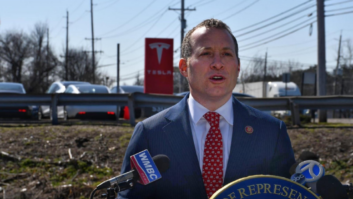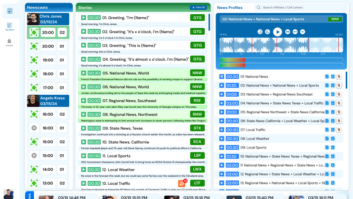INDIANAPOLIS — Paul Brenner isn’t your traditional NAB Radio Engineering Achievement Award recipient. With a background steeped in information technology, he’s more comfortable with chip design than tweaking transmitters.

Paul Brenner reviews an HD Radio-enabled smartphone app with Samantha Kowal, a member of his design team.
Such a combination is less unusual than it once was. But Brenner reflects modern engineering in another way as well. He embraces the future of radio and isn’t afraid of change it will bring. In fact, he sees himself as trying to help define the medium’s future, and others agree.
At 43, the senior vice president and chief technology officer at Emmis Communications is admired for what colleagues call his forward thinking and strategic initiatives. Brenner’s job focuses on technology business development, industry partnerships, broadcast engineering strategy and development of fresh broadcasting and Internet content distribution systems.
However, many who know him say this award — bestowed since 1959 to industry leaders — doesn’t merely recognize Brenner’s 9-to-5 accomplishments. It reflects the contributions that Brenner has made toward radio throughout a varied career.
These include working on initiatives to encourage the inclusion of HD Radio as standard in smartphones; helping Garmin launch an HD Radio-based traffic system last October; and serving on the HD Radio Technical Standards Task Force. In that capacity he has worked with CBS Radio Senior Vice President of Engineering Glynn Walden to identify what broadcasters need to deliver a consistent digital radio and data services experience.

Emmis technology managers in 2002.Kneeling, from left: Sam Caputa, Jeff Dinsmore, Jim Henkel, Ryan Blastick, Curtis Taylor. Standing: Joe Addalia, Paul Brenner, Brian Rozelle, Dennis Martin, Patrick Berger, Jim McGivern and Steve Pepe. Prior to joining Emmis in 1998, Brenner spent seven years in IT consulting, including a stint at DataShare Corp. He started an IT systems consulting company in the early 1990s called MIS Business Solutions, an Elektek-funded venture. The first IT product he developed was a tool for converting analog modem-based e-mails into Internet-compatible formats, used by a Fox affiliate in 1993.
“I really benefited from that time in IT,” Brenner says. “I’ve designed IT systems and designed software, infrastructures and business models around IT.
“To me, the broadcast piece is just the distribution mechanism.”
Non-traditional career path
Brenner runs every aspect of technology at Emmis. He oversees IT, the Web and all engineering services for the group’s two AM and 18 FM radio stations, including oversight of station chief engineers. In all, about 40 people report to Brenner. In turn he reports to Emmis COO/CFO Patrick Walsh.
What Peers Say:
Paul is one of a few real forward-thinkers in this industry and an excellent example of a balanced, sophisticated media technology leader. I’m proud to be able to work with him.
Barry Thomas, CPBE CBNT
Vice President of Engineering
Lincoln Financial Media
Paul’s background in IT combined with broadcast engineering expertise has enabled Paul to work effectively with automakers, software companies and portable device makers. His success with these companies lead to the formation a data distribution business, the Broadcaster Traffic Consortium, a partnership of more than 16 radio companies using FM RDS and HD Radio technology.
John Marino
Vice President, Technology
National Association of Broadcasters The non-traditional broadcast engineering career path for Brenner — not steeped in hands-on electronics — has created an inclusive management style for his department. He holds a bachelor’s degree in e-business and a master’s in information systems from University of Phoenix, as well as an sssociate’s in electronic engineering technology from Ivy Tech State College in Indiana.
“I understand transmitters and antennas, but I am by no means an expert. I’m better at computer design.” He credits his “very bright RF engineers” with taking on “the responsibility of maintaining the RF environment.” It’s a team he says he respects and trusts.
The engineers, of course, “are just one component of a broad team; and that is really what this industry has become,” Brenner says.Emmis has employees who write software, create infrastructure design and conduct business analysis.
The radio industry at large has some “big decisions to make,” Brenner says.
Honor Roll
Past winners of the NAB Engineering Achievement Award are listed. Beginning in 1991, radio and TV winners were named; radio winners are shown.
1959 John T. Wilner
1960 T.A.M. Craven
1961 Raymond F. Guy
1962 Ralph N. Harmon
1963 Dr. George R. Town
1964 John H. DeWitt Jr
1965 Edward W. Allen Jr.
1966 Carl J. Meyers
1967 Robert M. Morris
1968 Howard A. Chinn
1969 Jarrett L. Hathaway
1970 Philip Whitney
1971 Benjamin Wolfe
1972 John M. Sherman
1973 A. James Ebel.
1974 Joseph B. Epperson
1975 John D. Silva
1976 Dr. Frank G. Kear
1977 Daniel H. Smith
1978 John A. Moseley
1979 Robert W. Flanders
1980 James D. Parker
1981 Wallace E. Johnson
1982 Julius Barnathan
1983 Joseph Flaherty
1984 Otis S. Freeman
1985 Carl E. Smith
1986 Dr. George Brown
1987 Renville H. McMann
1988 Jules Cohen
1989 William Connolly
1990 Hilmer Swanson
1991 George Marti
1992 Edward Edison & Robert L. Hammett
1993 Robert M. Silliman
1994 Charles T. Morgan
1995 Robert Orban
1996 Ogden Prestholdt
1997 George Jacobs
1998 John Battison
1999 Geoffrey Mendenhall
2000 Michael Dorrough
2001 Arno Meyer
2002 Paul Schafer
2003 John W. Reiser
2004 E. Glynn Walden
2005 Milford Smith
2006 Benjamin Dawson & Ronald Rackley
2007 Louis A. King
2008 Thomas B. Silliman
2009 Jack Sellmeyer
2010 Steve Church
2011 L. Robert du Treil
“To remain relevant, we have to extend the technical side and increase utilization, make it digital; and the industry has to come together, and we all have to do it the same way.”
Radio needs to offer a consistent consumer experience, according to the award-winner. Over the past few years, Emmis has focused capital expenditures on HD Radio improvements and customer relationship management, CRM, for radio.
Radio is “just realizing how much there is we can do with our spectrum,” Brenner says. “There is a lot of value and in order to stay competitive, it has to be digitally-encoded spectrum, offering all of the advance capabilities digital radio can offer.” Multiple channels on the same carrier, as well as data services and a more consistent user experience doesn’t require custom software development by third parties, Brenner said.
Brenner is diversified in his media commitments. In addition to his work for Emmis, he founded and serves as president of the Broadcaster Traffic Consortium, a coalition of 16 radio broadcasters launched in 2008 to distribute local traffic, weather and other map-related data via RDS and HD Radio technology. BTC has established a nationwide network of aggregated analog and digital signals as a data delivery platform.
Garmin introduced the nüvi 3490LMT personal navigation device last fall; it was the first Garmin PND to include HD Digital Traffic. The company also introduced the 2400 and 2500 series, which are HD Radio-enabled, according to Brenner. All the devices use Navteq real-time traffic, distributed using the signals of BTC HD Radio stations.
The service updates every 30 seconds, according to Garmin. More models and capability are planned, Brenner says.
‘Silicon Valley moment’
Meanwhile, Emmis, Intel and iBiquity — along with BIA/Kelsey — have collaborated on a smartphone with an integrated FM HD Radio chip. The trio will demo a device in Las Vegas at the 2012 NAB Show. The partnership was born during a “Silicon Valley moment,” he says.
“More than two years ago I sat in a Palo Alto office among a group of chip design leaders, white-boarding and brainstorming the overall system of delivering content via HD Radio to smartphones.” The result was a pitch to NAB that garnered the support of radio industry leaders.
NAB FASTROAD originally funded the project; FASTROAD is now managed by the new NAB Labs. NAB helped “to fund the design a complete ecosystem of an HD radio built into a smartphone with an app and a backend ecosystem that feeds synchronized data to the user. It will be a game changer,” Brenner says.
The move could open the door to FM capability in cell phones if wireless carriers buy in. The industry groups with which Brenner is involved are talking with wireless carriers, whom he says can’t wait to see the demos.
As the radio industry tries to navigate its future, Brenner wants to continue to advocate for a digital conversion for all of radio within the next 10 years. He’s worked with car manufacturers on ways to keep radio relevant in the dashboard.
Brenner lives in Indianapolis and is engaged to be married. He says that while he’s honored by the award, he doesn’t view receiving it as an individual thing.
“It’s really a reflection of all the people working around me. It tells us we are working on the right things. I appreciate the recognition, but I’m also so happy for all of the people working so hard on some really important radio developments.”












